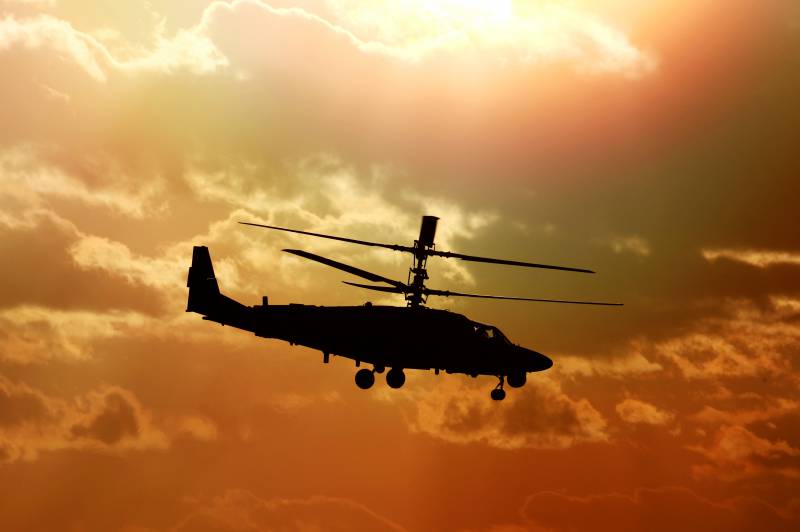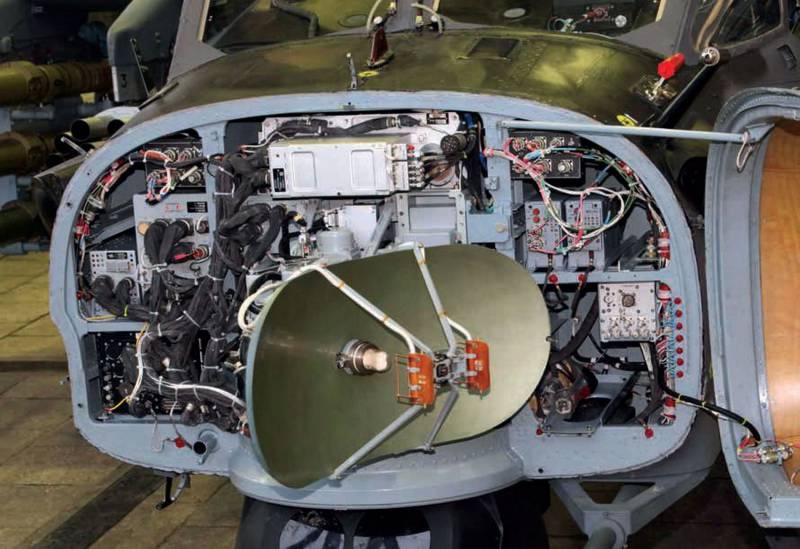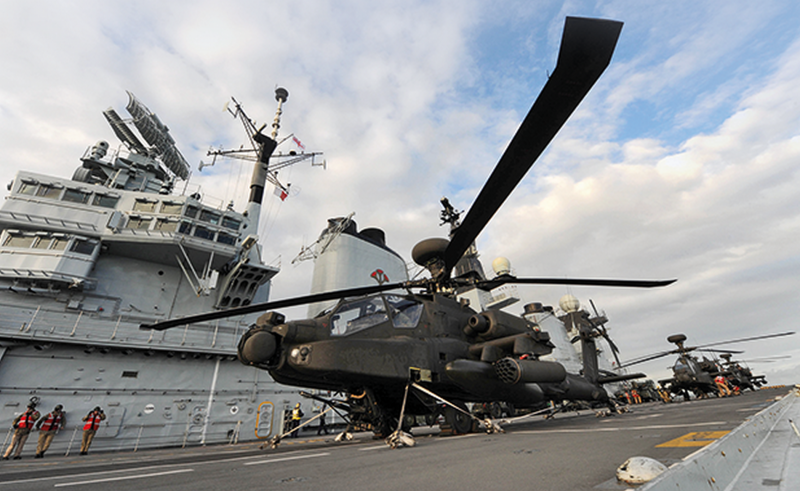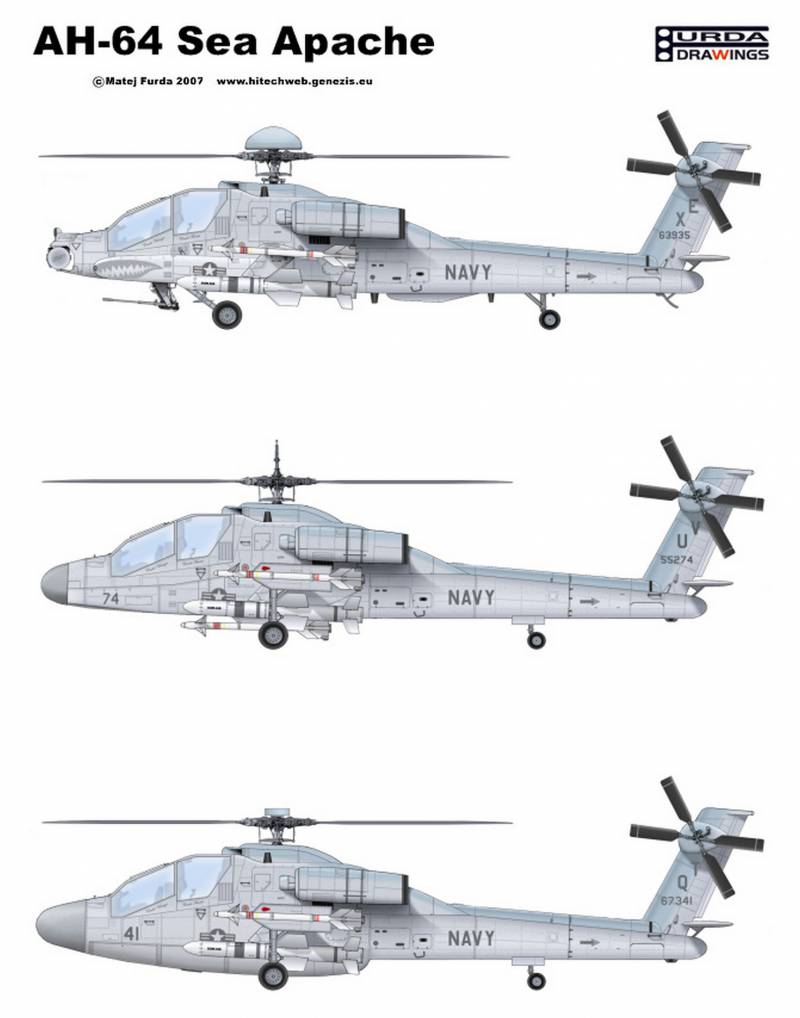"Katran" and "Apache" in comparing the autonomy of combat missions performed
Practically no one doubts the high efficiency of modern attack helicopters in the theater of military operations of the 21st century. So, in January-March 2000, in the conditions of the most difficult mountainous relief of the Chechen Republic of Ichkeria, the baptism of the most famous modern Russian attack helicopter Ka-50 “Black Shark” took place. Unique rotary-winged machines with a coaxial arrangement of 2's three-bladed propellers began the combat operation 6 of January 2000 of the year. And the first results of January 9 appeared - a mixed group of one Ka-50 and one Mi-24 destroyed a large ammunition depot with a dugout and an observation tower of the militants. The “black shark” played a major role in the operation, having divided directly the warehouse of the NURSami C-8, while “Hynd” cleared out the observation posts of the extremists. Later, 6 February 2000, already part of a full link, the pilots of the Ka-52 for the first time tried the 9K121 “Whirlwind” anti-tank missile system (ATGM) in combat, destroying in the mountain-wooded canyon near the settlement. Tsentora fortified militants with a training camp with only two anti-tank 9А4172 "Whirlwind".
Today, 16 years after the first demonstration of the high combat qualities of the “Black Shark” in the fight against illegal military formations within the country, the spectrum of helicopter attack helicopters required to perform combat missions aviation increased several times. The perfection of network-centric coordination, the accuracy and range of military air defense systems increased, which required the installation of new electronic countermeasures and more long-range and high-speed missile weapons on board helicopters. In addition, a probable adversary will have new airborne AWACS, which, thanks to improved methods for processing radar information and the greater energy of new radars with AFAR, are capable of detecting air targets against the background of the earth's surface (attack helicopters include them) from much greater distances, and then give them target designation to either multi-role fighter-interceptors, or SAM with ARGSN. This situation required domestic specialists to develop a completely new multifunctional helicopter complex, capable of taking on some of the operations previously assigned to multi-role tactical fighters, including deck modifications.
The deck version of the Ka-52 “Alligator” - Ka-52K “Katran” helicopter was used as the base, where the “K” is a ship-based one. "Katran" refers to the reconnaissance and shock class of helicopters. To do this, it is equipped with a sufficiently powerful dual-band airborne radar complex "Arbalet-L", operating in centimeter and millimeter wavelengths (X / Ka and L / Ka) and having a throughput (link trails targets / tracking on the aisle) 20 targets. The millimeter range allows you to detect and capture ultra-small air and ground targets, perform high-resolution mapping of the terrain, and also detect objects and obstacles that are practically invisible to other radars (high-voltage power lines, etc.). The accuracy of the millimeter part of the Ka-band is no more than 1-2 m, which allows the use of the Arbalet-L as a high-precision target designation complex. The centimeter X-band allows you to achieve a much longer target detection range (the tank is detected at a distance of 12 km, the middle bridge is 25 — 32 km, and the aerial attack-type aircraft is 15 km), but is slightly inferior to the Ka-range.
“Arbalet” has an open element base and specialized data buses for targeting the GOES-451 “Katran” optical-electronic target complex, which in a matter of seconds allows you to start using laser or TV targeting rockets with television and semi-active laser homing heads, as well as missiles with laser beam semi-automatic homing system. A very important feature of the "Crossbow" is the ability to detect small air targets that pose a threat to the Ka-52K "Katran". So, from the 5 km distance, the Zla portable Igla-S and Stinger anti-aircraft missile systems are detected, thanks to which the crew can perform anti-aircraft maneuver in time and release infrared traps.
Given the possibility of a ship-based Ka-52K, it was decided to endow the strike and reconnaissance vehicle with anti-ship capabilities. With the control system of armament-type "Argument-52" standardized anti-ship long-range missiles X-35 and X-31A. Due to the significantly larger mass of these missiles (610 kg in X-35U and 715 kg in X-31AD), the folding cantilevers were significantly shortened, which made it possible to place more than a ton of missile-bomb weapons on each suspension point. The airframe design is fully adapted to the overall weight increase of the helicopter, in particular, for ship-based racks and chassis attachment points were strengthened. A large group of X-NUMX-6 Ka-8 "Katran" can send to the bottom of the 52-3 frigate class "Oliver Perry", 4 class destroyer "Arley Burke" and disable the nuclear aircraft carrier-class "Nimitz". But there is one caveat: “Crossbow” has a detection range of a large 1 surface ship - 35 km, and therefore, using its own targeting means, Katrans will not be able to withstand the enemy’s enemy attack forces (ASN X-45U and X-35AD) will not be able to show all long-range abilities). A target designation will be required from the radars of the maritime patrol aircraft or the Ka-31-type airborne helicopter with the Oko complex on board. In this regard, it was decided to radically upgrade the radar Ka-31K.
Unlike American, Western European and Chinese attack helicopters, where the radar is usually installed in a nadtrutochny fairing, the Ka-52K can be installed in a massive radio transparent nose fairing, as is done on any modern fighter.
As the Radio Electronic Technologies Concern JSC reports, the Ka-52K Katran naval reconnaissance and attack helicopters will be upgraded with a promising compact on-board radar with an active phased array antenna. Like the Arbalet-L, the new station will be 2-band (centimeter and millimeter), but with higher accuracy and power of work. The use of modern electronic elemental base, as well as digital control of the AFAR beam, will allow mapping of the terrain with synthetic aperture at distances up to 60-80 (for a regular Crossbow - up to 35 km). The centimeter X-range will allow you to detect enemy ships at ranges up to 160 km. “Katrans” will be able to freely attack the enemy’s shipboard attack groups on the inaccessible or poorly reachable ranges of their air defense weapons. French frigates and British destroyers Lafayette and Daring can be safely attacked because their PAAMS do not overlap the radius of destruction of X-31AD supersonic anti-ship missiles (helicopter pilots do not need to approach the enemy with less than 80 — 100 x and during the low-altitude flight of the “Katranov”, the Aster-30 SAM at this distance does not pose a threat).
A more difficult situation can be traced in the confrontation with the American naval strike groups. The majority of the Aegis ships of the US Navy today are receiving long-range interceptor interceptors RIM-174 ERAM (SM-6). The range of these missiles is close to 240 km, and it is similar to approaching on the Katran from such KUG only to 100 km of death, especially if at least one E-3C aircraft capable of issuing Ejis and ERAM target designation of helicopters is on duty in TVD airspace. Therefore, X-31AD cannot be used in this case, and it remains to rely on X-35UE, the destruction range of which reaches 260 km, although it will have to come to terms with the subsonic speed of the missiles, which will need to be compensated for by a large number of them. And external target designation will again be required, since the instrumental range of the “afarized” “Crossbow” will reach 190 — 200 km.
But despite all the moments, the new radar will turn the earlier attack helicopter “Katran” into a unique rotary-winged platform capable of using the widest range of rocket weapons for any type of target within 150 — 180 km radius completely autonomous, without the need to engage reconnaissance complexes of sea, ground and air home base. If conventional "Alligators" could use air-to-air missiles of the P-73 melee as a means of self-defense, and to destroy low-speed targets (up to 0,8М), the Whirlwind missiles, then Katrans with AFARmi can take the board is already a couple of P-77 (RVV-AE) or RVV-SD, with the help of which they will be able to engage in air combat with absolutely any fighter of the 4 ++ generation, intercept enemy cruise missiles, defending any strategic object. More on this.
The payload of the Ka-52K Katran is approximately 2 tons, due to which each machine can take up to 170-6 RVV-SD missiles on modified aircraft ejection devices of the AKU-8E type. And no matter how absurd it may sound, “Katrans” with such “equipment” can become excellent “hunters” for cruise missiles and Drones in the structure of the positional air defense-missile defense of one or another defended object.
Imagine a friendly territory in the theater, where the enemy almost completely destroyed ground-based air defense with anti-radar missiles and massive strikes of strategic CDs, “crushed” the airfield runways, and at one of the strategic enterprises, either an emergency evacuation of personnel or personnel was carried out helicopters of military transport aviation. Almost all of the "Drying" and "MiG" in the missions to gain air superiority over enemy aircraft. And to allow for the operation of the Mi-26 without proper escorting - to expose the crew of the helicopter and the evacuated contingent to mortal danger. The link (group) of Ka-52K, armed with RVV-SD, will ensure the complete safety and efficiency of such an operation. Helicopters will not need a long runway, and until an emergency situation, the vehicles can be hidden in a small camouflaged hangar. Recall that the Katran, unlike the Alligator, has folding blades and wings, which was originally designed for compact placement on helicopters of the type Mistral and other types of combat surface ships.
Also, when defending a military base or a shipborne attack force led by a helicopter carrier, the Katrans with powerful AFAR radars and medium-range air combat missiles could easily replace the radar and guidance aircraft and a pair of ground or naval air defense together. First, the RVV-SD missiles launched by the approaching enemy cruise missiles previously detected by helicopter radars have a range of 30-70% greater than the ground-based Pantsiri, Buk-М1-2 and other systems. A group of 10 helicopters will be able to shoot up to 50 — 60 high-precision means weapons the enemy even before the start of ground-based air defense missile systems, which will facilitate the work of the calculations of military air defense. The high performance of the updated Katrans in the fight against the air enemy is not even discussed, because the promising radar developed by KRET will have at least 4-6 target channels.
The presence of an advanced optical-electronic sighting system GOES-451, produced by the Production Association Ural Optical-Mechanical Plant named after E.S. Yalamov ", part of the holding" Shvabe ". Unlike the gyro-stabilized OLPK “Samshit-E” installed on the first “Alligators”, the GOES-451 has a more advanced system for processing the received TV image “Hunter”, which is more sensitive than the previous one by 50. Thus, ground-based armored vehicles are detected in the infrared channel at night at a distance of more than 6 km. The complex performs the whole range of tasks for detecting, tracking and defeating sea and ground targets both autonomously (in satisfactory meteorological conditions) and in synchronization with on-board radars (in fog, snow, rain, or with increased dustiness and smoke of the battlefield).
The most advanced highly sensitive complex of electronic intelligence and personal protection "Vitebsk" in the helicopter technology deserves special respect. The elemental base of this electronic warfare complex is built around an L-370-PNNUMX Active Digital Station (CSAP), whose onboard computer performance is significantly higher than that of the most well-known “Sorption” installed on the wing tips of Su-2С / SM fighters. Vitebsk can produce simulation and wideband interference, depending on the type of the irradiating signal of the enemy, and, accordingly, the type of the emitting radar. The latter is identified using a modern radiation warning system, which is fundamentally different from SPR-27LM "Birch". But it is worth noting that helicopter modifications have only a channel of optical-electronic suppression, which allows to cover only from missiles and air-to-air missiles with Stinger-type ICGSN, AIM-15X Block I / II and so on. It is possible that later the electronic suppression channel will be put into operation, as is done in the basic version of the L-9-370С.
WHAT HAS OUR ACCOUNT COMPETITOR APACH LONGBOU / GARDIAN REACHED?
According to a publication posted on 26 2016 on the Military Parity website in July with reference to Western sources, the leading European corporation, the manufacturer of rocket technology MBDA, offers the UK Sun to contract for the purchase of a large batch of Brimstone-2 high-precision tactical missiles for 50 planned for the purchase of American attack helicopters AH-64E "Apache Guardian". All Apaches should be commissioned by the British Army by 2023. Considering that the rockets got along quite well in the missile arsenal of the tactical strike fighters Tornado GR4, the conclusion of the contract is not in doubt.
The integration of Brimstone-2 on the Apache is as significant as the similar procedure with the jointly developed Lockheed Martin / Raytheon US tactical multi-purpose JAGM missiles, because today only these missiles increase the combat potential of the main American attack rotor wing cars, which in the 21st century no longer responds to threats appearing in the theater of military operations.
The improved Brimstone-2 rocket received a new rocket engine with a longer duration of operation, due to which the range increased from 12 to 40 km during launch from the attack helicopter. The improved 2 hkalnaya homing head provides a high percentage of hitting both ground heavy combat armored vehicles and lightly armored vehicles and vehicles with speeds above 100 km / h. Perhaps this is due to the high-frequency ARGSN millimeter-wave (frequency up to 94 GHz), which does not require a delay in correcting the laser illumination of the carrier for a highly maneuvering target. In addition, active radar targeting makes the Brimstone-2 rocket invulnerable to grenade launchers for the installation of a smoke screen and optical-electronic interference complexes installed on many modern MBTs. The open architecture of the GOS modules allows programming of various standards for semi-active laser homing systems corresponding to the digital channels of the laser target designators of land, air and ship-based bases of both NATO and other countries (in NATO, this is STANAG-3733). The rocket has two main modes of attack ground targets - for complex maneuvering targets and for "dense" group target. In the latter case, the rocket is launched on the principle of “let-forget” and in the process independently selects targets and selects the highest priority with the help of ARGSN.
Thanks to the ARGSN millimeter channel, the round-up probable missile deflection does not exceed the 1 meter, which, in the presence of a tandem cumulative warhead, can cause only minimal damage to friendly forces that have entered the near confrontation with the enemy. The result: the range of fire impact of the most modern version of the Apache - 40 km, which is 4 times less than that of our "Katran". But how are these 40 km achieved?
Naturally, not with the AH-64E helicopter armament control complex, but with the help of external target designation of more serious means of optical radio electronic reconnaissance and target designation. For this purpose, the Boeing company specialists equipped the strike machine with tactical information exchange bus through the Link-16 radio channel, as well as the UAV control radio channel. It is the ability to control the UAV with the receipt of telemetric TV / IR images of the battlefield beyond visual visibility allows the Apache to show all the qualities of the Brimstone-2 and JAGM missiles. Otherwise, it would be limited by the characteristics of the Ka-band AN / APG-78 supra-sleeve radar (8-10 km) and the TADS optical-electronic sighting IR / TV system, the range of which depends solely on the meteorological conditions and the level of smoke in the area of the theater military action. The only advantage of the AN / APG-78 radar is the high bandwidth in 256 accompanied by ground and airborne targets.
The Brimstone-2 rocket, despite the increased range, is not a unique model of precision weapons. Like all known versions of the AGM-114 "Hellfire" family of anti-tank missiles, the Brimstone-2 has a maximum flight speed of around 1,5-1,6М, which, when approaching the target, drops to 1000 - 1200 km / h. The rocket becomes an excellent target for any modern troop self-propelled anti-aircraft missile system from Tor-M1-2U to Artillery-С1 О, not to mention the Buk-МХNUMX and С- anti-aircraft missile systems. 3 Triumph. Brimstone-400 is a slow and easily intercepted missile, and it also has no anti-aircraft maneuver program. It is very easy to reduce it from the trajectory with powerful noise and masking radio-electronic interference, or to destroy the electronic filling with microwave radiation of the “Ranets-E” type of microwave protection system. The low speed of the rocket allows countermeasures to influence the Brimstone-2 guidance systems for as long as possible. The same will happen when this rocket hits a radius of destruction of existing and prospective active protection systems (KAZ) of the “Arena” or “Afganit” type, the emphasis on which will increase manyfold in the near future of the Russian Federation.
The Apache Guardian has no constructive capabilities to quickly install a full-fledged on-board radar with an active phased array antenna, while the AH-64 project Sea Apache (Sea Apache), which McDonnel Douglas Helicopter has been working with since 1984, later was closed. The program, designed for the US Marine Corps, provided for the installation in the nose of the AH-64 fuselage on-board radar with an AN / APG-65 slot antenna array, which was also installed on earlier versions of the F / A-18A Hornet deck fighter jets . The station would allow Apache to use AIM-7M missiles, and later AIM-120C, to fight enemy naval aviation, as well as cruise and anti-ship missiles. The company also planned to equip the Sea Apache with the Harpoon anti-ship missiles.
It is very interesting that even after equipping the Sea Apache with the standard AN / APG-65 Hornet Radar from Hughes, the helicopter would receive an almost complete armament control system from a two-seat modification of the F / A-18B carrier-based fighter with the possibility of using anti-radar missiles AGM-88 HARM. As you know, Apache is capable of flying in 5 — 10 m above the surface, in this case the use of HARM could be a real surprise for the enemy’s radar and air defense missile systems. The installation of an optical-electronic sighting system on the Marine Apache in addition to the radar was not envisaged, but could still be implemented. The rotating module could be installed under the nose of the helicopter's fuselage, as was done in the Ka-52K, and therefore the helicopter was able to use anti-tank Hellfire missiles with semi-active laser seeker. Missile family "Maverick" with TV / IKGSN could be used on "Sea Apache" and without auxiliary optical-electronic means.
AH-64A / D / E has lost a lot of opportunities without getting upgraded by the Sea Apache program, and today it lags behind the Ka-52K Katran not only by individual capabilities, but by a whole range of qualities that determine a combat helicopter as a promising multifunctional shock platform.
Information sources:
http://www.airwar.ru/enc/ah/ka52k.html
http://www.airwar.ru/enc/ah/ka50.html
http://www.airwar.ru/enc/ah/ah64e.html
http://www.aviastar.org/helicopters_eng/mcdonnell_sea_apache.php
https://mbdainc.com/wp-content/uploads/2015/11/Brimstone2-Data-Sheet_Nov-2015.pdf
http://forum.militaryparitet.com/viewtopic.php?pid=159472#p159472
http://forum.militaryparitet.com/viewtopic.php?id=8280





Information